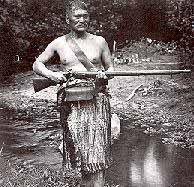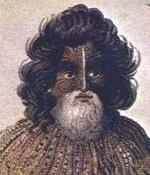![]()
the Maori history in Aotearoa - Musket wars
![]()
the Maori history in Aotearoa - Musket wars

The first to collect substantial firearms, the Ngapuhi, also aquired a new knowledge of the tribal areas around New Zealand, discovered from trade and crewing on European vessels
This led to a new appraisal of war - war could be carried far from the traditional tribal region because the army became well-nigh invincible, and while it may not have been expansionist, certainly the acquisition of new lands was an attractive benefit.
Maori were learning, from Europeans, and from their own discoveries abroad, about modern warfare - the American Wars of Independance were over, and the Napoleonic Wars had just ended, with the military strategems learnt. The Maori were acquiring capable military training by studying Pakeha.
Muskets became the most desired of all the Pakeha trade items, and consequently the price went up - a musket eventually traded for 3 tons of dressed flax. That is an incredible amount of processed flax, and to garner it, food cultivation was neglected. Slaves were pressed into service, and then more slaves were needed, thus increasing the need to wage war.
Slaves were also traded, with a musket being worth 3 to 5 slaves. In the Bay of Plenty a musket was worth 3 tons of potatoes and 8 pigs.
The muskets were not necessarily very good. 'Brummagen' is an abberation of the word 'Birmingham', the city where mass-produced muskets were being churned out. There was always a real chance that the Maori warrior using such a weapon would kill himself instead of a foe with backfirings - or that it wouldn't fire at all.
The other problem was ammunition, and Maori were often forced to make their own, from nails, hard puriri wood, or lead poured into pipe bowls. Gunpowder could be procured but not necessarily percussion caps to ignite the powder - 18 pence-worth of caps could have been sold by a shopkeeper for £ 300 worth of gold to a Maori (Sir JE Alexander, 'Incidents of the Maori war' 1863) but the shopkeeper refused - others were not so scrupulous. In a pinch, percussion caps were made with match heads in boot eyelets.
Nonetheless, against an enemy who had to get within reach to thrust a spear or swing his mere, the odds were massively in favour of the musket-wielding warrior who could deal death from a safe distance.
New Zealand had become a small country under siege, where sudden death by ambush waited in any bush or clearing, valley or beach. Tribes now travelled as small armies, bringing their slaves with them as a food source.

Hongi Hika had amassed a force of 800 fighting men by 1817 and when he launched a revenge raid against the Ngatiporou of the Bay of Plenty in early 1818, he set in motion the bloody conflict known as the Musket Wars.
At it's end, a quarter of the native population lay dead.
He was exacting revenge for the loss of a female relative, the niece of Te Morenga, who had been abandoned, to possibly be killed and eaten by the Ngatiporou.
She had been kidnapped by Australian convicts who had hijacked a ship, the "Venus" in 1806, and fled to New Zealand on it, from her home in the Bay of Islands.
As a modus operandi, the convicts had sailed down the coast, kidnapping women and selling them at the next landfall. They had also siezed Te Morenga's sister at Whangarei and disposed of her in barter to the Ngaiterangi at Motiti Island, where she was later killed.
Te Morenga had 400 warriors with him, and Hongi Hika, who had allied with Te Haupa of the Ngatipaoa, commanded 900 men. Both forces devastated the Bay of Plenty.
Hongi Hika later told Marsden that he had killed over 500 in the Bay of Plenty, and when he returned to his northern home, one canoe was loaded with 70 decapitated heads.
New Zealand.org.nz Homepage here
This
Web Directory will always be dynamic ~
all details are flexible and changing